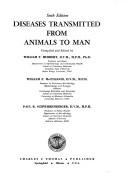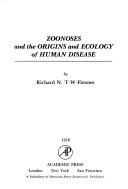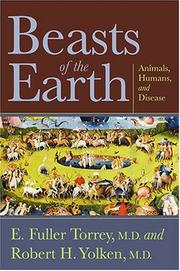| Listing 1 - 10 of 13 | << page >> |
Sort by
|
Book
ISBN: 2130379435 9782130379430 Year: 1983 Volume: 2094 Publisher: Paris PUF
Abstract | Keywords | Export | Availability | Bookmark
 Loading...
Loading...Choose an application
- Reference Manager
- EndNote
- RefWorks (Direct export to RefWorks)
Zoonoses --- Zoonose --- Épidémiologie --- Epidemiology --- Thérapeutique --- therapy --- Zoonoses. --- 619 --- Zoonotic Diseases --- Zoonotic Infections --- Zoonotic Infectious Diseases --- Disease, Zoonotic --- Disease, Zoonotic Infectious --- Diseases, Zoonotic --- Diseases, Zoonotic Infectious --- Infection, Zoonotic --- Infections, Zoonotic --- Infectious Disease, Zoonotic --- Infectious Diseases, Zoonotic --- Zoonotic Disease --- Zoonotic Infection --- Zoonotic Infectious Disease --- Disease Reservoirs --- Public Health --- Communicable Diseases, Emerging --- Zoonotic Spillover --- Spillovers, Zoonotic --- Zoonotic Spillovers --- Maladies infectieuses --- Maladie animale --- Transmissibilite a l'homme
Book
ISBN: 0849329124 Year: 1981 Publisher: Boca Raton CRC
Abstract | Keywords | Export | Availability | Bookmark
 Loading...
Loading...Choose an application
- Reference Manager
- EndNote
- RefWorks (Direct export to RefWorks)
Zoonoses. --- Zoonotic Diseases --- Zoonotic Infections --- Zoonotic Infectious Diseases --- Disease, Zoonotic --- Disease, Zoonotic Infectious --- Diseases, Zoonotic --- Diseases, Zoonotic Infectious --- Infection, Zoonotic --- Infections, Zoonotic --- Infectious Disease, Zoonotic --- Infectious Diseases, Zoonotic --- Zoonotic Disease --- Zoonotic Infection --- Zoonotic Infectious Disease --- Disease Reservoirs --- Public Health --- Communicable Diseases, Emerging --- Virus diseases. --- Zoonotic Spillover --- Spillovers, Zoonotic --- Zoonotic Spillovers --- Zoonoses
Book
ISBN: 9782889196180 Year: 2015 Publisher: Frontiers Media SA
Abstract | Keywords | Export | Availability | Bookmark
 Loading...
Loading...Choose an application
- Reference Manager
- EndNote
- RefWorks (Direct export to RefWorks)
Zoonoses are currently considered as one of the most important threats for Public Health worldwide. Zoonoses can be defined as any disease or infection that is naturally transmissible from vertebrate or invertebrate animals to humans and vice-versa. Approximately 75% of recently emerging infectious diseases affecting humans are diseases of animal origin; approximately 60% of all human pathogens are zoonotic. All types of potential pathogenic agents, including viruses, parasites, bacteria and fungi, can cause these zoonotic infections. From the wide range of potential vectors of zoonoses, insects are probably those of major significance due to their abundance, high plasticity and adaptability to different kinds of pathogens, high degrees of synanthropism in several groups and difficulties to apply effective programs of population control. Although ticks, flies, cockroaches, bugs and fleas are excellent insects capable to transmit viruses, parasites and bacteria, undoubtedly mosquitoes are the most important disease vectors. Mosquito borne diseases like malaria, dengue, equine encephalitis, West Nile, Mayaro or Chikungunya are zoonoses with increasing incidence in last years in tropical and temperate countries. Vertebrates can also transmit serious zoonoses, highlighting the role of some carnivorous animals in rabies dissemination or the spread of rodent borne diseases in several rural and urban areas. Moreover, the significance of other food borne zoonoses such as taeniasis, trichinellosis or toxoplasmosis may not been underestimated.According to WHO, FAO and OIE guidelines an emerging zoonotic disease can be defined asa zoonosis that is newly recognized or newly evolved, or that has occurred previously but shows an increase of incidence or expansion in geographical, host or vector range. There are many factors that can provoke or accelerate the emergence of zoonoses, such as environmental changes, habitat modifications, variations of human and animal demography, pathogens and vectors anomalous mobilization related with human practices and globalization, deterioration of the strategies of vector control or changes in pathogen genetics. To reduce Public Health risks from zoonoses is absolutely necessary to acquire an integrative perspective that includes the study of the complexity of interactions among humans, animals and environment in order to be able to fight against these issues of primary interest for human health. In any case, although zoonoses represent significant Public Health threats, many of them still remain as neglected diseases and consequently are not prioritized by some health international organisms.The aim of this Research Topic is to cover all related fields with zoonoses, including basic and applied researches, approaches to control measures, explanations of new theories or observations, opinion articles, reviews, etc. To deeply discuss these issues, a holistic and integrative point of view is obviously needed and guided by the “One Health” strategy. Consequently the ambitious goal of this Research Topic will be only achieved by the collaboration of researchers specialized in different fields as medical and veterinary entomologists, parasitologists, veterinarians, virologists, zoologists, microbiologists, ecologists, evolutionary biologists and medicals specialized in epidemiology and public health. The participation of multiple contributors will be very important to comply with a knowledge demand of this issue of first-rate of scientific and medical interest.
Zoonoses. --- Transmission of Disease --- Public Health --- Health & Biological Sciences --- Zoonotic Diseases --- Zoonotic Infections --- Zoonotic Infectious Diseases --- Disease, Zoonotic --- Disease, Zoonotic Infectious --- Diseases, Zoonotic --- Diseases, Zoonotic Infectious --- Infection, Zoonotic --- Infections, Zoonotic --- Infectious Disease, Zoonotic --- Infectious Diseases, Zoonotic --- Zoonotic Disease --- Zoonotic Infection --- Zoonotic Infectious Disease --- Disease Reservoirs --- Communicable Diseases, Emerging --- Zoonotic Spillover --- Spillovers, Zoonotic --- Zoonotic Spillovers --- trypanosomatids --- epidemiology --- Borrelia --- one health --- emerging infectious diseases --- vector borne diseases --- Brucella --- zoonoses --- rickettsiae --- arbovirus
Book
ISBN: 0702006327 Year: 1977 Publisher: London Bailliere Tindall
Abstract | Keywords | Export | Availability | Bookmark
 Loading...
Loading...Choose an application
- Reference Manager
- EndNote
- RefWorks (Direct export to RefWorks)
Bacterial Infections --- Virus Diseases --- Zoonoses. --- Bacterial diseases --- -Virus diseases --- -Zoonoses --- Animal-borne diseases --- Communicable diseases between animals and human beings --- Zoonotic diseases --- Communicable diseases --- Animals as carriers of disease --- Viral diseases --- Viral infections --- Virus infections --- Medical virology --- Pathogenic viruses --- Bacterial infections --- Medical bacteriology --- Pathogenic bacteria --- Zoonotic Diseases --- Zoonotic Infections --- Zoonotic Infectious Diseases --- Disease, Zoonotic --- Disease, Zoonotic Infectious --- Diseases, Zoonotic --- Diseases, Zoonotic Infectious --- Infection, Zoonotic --- Infections, Zoonotic --- Infectious Disease, Zoonotic --- Infectious Diseases, Zoonotic --- Zoonotic Disease --- Zoonotic Infection --- Zoonotic Infectious Disease --- Disease Reservoirs --- Public Health --- Communicable Diseases, Emerging --- transmission. --- Transmission --- Virus diseases --- BACTERIAL INFECTIONS --- VIRUS DISEASES --- Zoonoses --- Transmission. --- transmission --- Zoonotic Spillover --- Spillovers, Zoonotic --- Zoonotic Spillovers

ISBN: 0398030561 Year: 1975 Publisher: Springfield (Ill.) Thomas
Abstract | Keywords | Export | Availability | Bookmark
 Loading...
Loading...Choose an application
- Reference Manager
- EndNote
- RefWorks (Direct export to RefWorks)
Zoonoses. --- 616.9 --- Zoonoses --- Animal-borne diseases --- Communicable diseases between animals and human beings --- Zoonotic diseases --- Communicable diseases --- Animals as carriers of disease --- Zoonotic Diseases --- Zoonotic Infections --- Zoonotic Infectious Diseases --- Disease, Zoonotic --- Disease, Zoonotic Infectious --- Diseases, Zoonotic --- Diseases, Zoonotic Infectious --- Infection, Zoonotic --- Infections, Zoonotic --- Infectious Disease, Zoonotic --- Infectious Diseases, Zoonotic --- Zoonotic Disease --- Zoonotic Infection --- Zoonotic Infectious Disease --- Disease Reservoirs --- Public Health --- Communicable Diseases, Emerging --- Communicable diseases. Infectious and contagious diseases, fevers --- 616.9 Communicable diseases. Infectious and contagious diseases, fevers --- Zoonotic Spillover --- Spillovers, Zoonotic --- Zoonotic Spillovers

ISBN: 0122560507 Year: 1978 Publisher: London Academic press
Abstract | Keywords | Export | Availability | Bookmark
 Loading...
Loading...Choose an application
- Reference Manager
- EndNote
- RefWorks (Direct export to RefWorks)
Ecology. --- Zoonoses. --- Epidemiology --- Zoonoses --- 616-022.39 --- $?$4/87 --- Animal-borne diseases --- Communicable diseases between animals and human beings --- Zoonotic diseases --- Communicable diseases --- Animals as carriers of disease --- Diseases --- Public health --- Zoonotic Diseases --- Zoonotic Infections --- Zoonotic Infectious Diseases --- Disease, Zoonotic --- Disease, Zoonotic Infectious --- Diseases, Zoonotic --- Diseases, Zoonotic Infectious --- Infection, Zoonotic --- Infections, Zoonotic --- Infectious Disease, Zoonotic --- Infectious Diseases, Zoonotic --- Zoonotic Disease --- Zoonotic Infection --- Zoonotic Infectious Disease --- Disease Reservoirs --- Public Health --- Communicable Diseases, Emerging --- Environmental Science --- Bionomics --- Ecologies --- Environmental Sciences --- Science, Environmental --- Sciences, Environmental --- Environmental Psychology --- Conservation of Natural Resources --- Environmental Health --- Ecosystem --- Epidemiology. --- Ecology --- Zoonotic Spillover --- Spillovers, Zoonotic --- Zoonotic Spillovers

ISBN: 1280462825 9786610462827 0813537894 9780813537894 9780813535715 0813535719 Year: 2005 Publisher: New Brunswick, NJ
Abstract | Keywords | Export | Availability | Bookmark
 Loading...
Loading...Choose an application
- Reference Manager
- EndNote
- RefWorks (Direct export to RefWorks)
Humans have lived in close proximity to other animals for thousands of years. Recent scientific studies have even shown that the presence of animals has a positive effect on our physical and mental health. People with pets typically have lower blood pressure, show fewer symptoms of depression, and tend to get more exercise. But there is a darker side to the relationship between animals and humans. Animals are carriers of harmful infectious agents and the source of a myriad of human diseases. In recent years, the emergence of high-profile illnesses such as AIDS, SARS, West Nile virus, and bird flu has drawn much public attention, but as E. Fuller Torrey and Robert H. Yolken reveal, the transfer of deadly microbes from animals to humans is neither a new nor an easily avoided problem. Beginning with the domestication of farm animals nearly 10,000 years ago, Beasts of the Earth traces the ways that human-animal contact has evolved over time. Today, shared living quarters, overlapping ecosystems, and experimental surgical practices where organs or tissues are transplanted from non-humans into humans continue to open new avenues for the transmission of infectious agents. Other changes in human behavior like increased air travel, automated food processing, and threats of bioterrorism are increasing the contagion factor by transporting microbes further distances and to larger populations in virtually no time at all. While the authors urge that a better understanding of past diseases may help us lessen the severity of some illnesses, they also warn that, given our increasingly crowded planet, it is not a question of if but when and how often animal-transmitted diseases will pose serious challenges to human health in the future.
Disease Transmission --- Disease Outbreaks --- Zoonoses --- Animal-borne diseases --- Communicable diseases between animals and human beings --- Zoonotic diseases --- Communicable diseases --- Animals as carriers of disease --- Zoonotic Diseases --- Zoonotic Infections --- Zoonotic Infectious Diseases --- Zoonotic Spillover --- Disease, Zoonotic --- Disease, Zoonotic Infectious --- Diseases, Zoonotic --- Diseases, Zoonotic Infectious --- Infection, Zoonotic --- Infections, Zoonotic --- Infectious Disease, Zoonotic --- Infectious Diseases, Zoonotic --- Spillovers, Zoonotic --- Zoonotic Disease --- Zoonotic Infection --- Zoonotic Infectious Disease --- Zoonotic Spillovers --- Disease Reservoirs --- Public Health --- Communicable Diseases, Emerging --- Infectious Disease Outbreaks --- Outbreaks --- Disease Outbreak --- Disease Outbreak, Infectious --- Disease Outbreaks, Infectious --- Infectious Disease Outbreak --- Outbreak, Disease --- Outbreak, Infectious Disease --- Outbreaks, Disease --- Outbreaks, Infectious Disease
Periodical
Abstract | Keywords | Export | Availability | Bookmark
 Loading...
Loading...Choose an application
- Reference Manager
- EndNote
- RefWorks (Direct export to RefWorks)
Transboundary animal diseases --- Animals --- Veterinary medicine --- Animaux --- Médecine vétérinaire --- Peridicals --- Diseases --- Periodicals. --- Maladies transfrontières --- Périodiques --- Maladies --- Animal Diseases. --- Veterinary Medicine. --- Zoonoses. --- Disease Outbreaks. --- Veterinary medicine. --- Life Sciences --- Animal Physiology --- Veterinary epidemiology --- Farriery --- Large animal medicine --- Large animal veterinary medicine --- Livestock medicine --- Veterinary science --- Infectious Disease Outbreaks --- Outbreaks --- Disease Outbreak --- Disease Outbreak, Infectious --- Disease Outbreaks, Infectious --- Infectious Disease Outbreak --- Outbreak, Disease --- Outbreak, Infectious Disease --- Outbreaks, Disease --- Outbreaks, Infectious Disease --- Zoonotic Diseases --- Zoonotic Infections --- Zoonotic Infectious Diseases --- Disease, Zoonotic --- Disease, Zoonotic Infectious --- Diseases, Zoonotic --- Diseases, Zoonotic Infectious --- Infection, Zoonotic --- Infections, Zoonotic --- Infectious Disease, Zoonotic --- Infectious Diseases, Zoonotic --- Zoonotic Disease --- Zoonotic Infection --- Zoonotic Infectious Disease --- Medicine, Veterinary --- Diseases, Animal --- Disease --- veterinary --- Animal Diseases --- Veterinary Medicine --- Zoonoses --- Disease Outbreaks --- Veterinary --- Medicine --- Animal health --- Domestic animals --- Livestock --- Space-Time Clustering --- Disease Reservoirs --- Public Health --- Communicable Diseases, Emerging --- Animal Husbandry --- Losses --- veterinary. --- Zoonotic Spillover --- Spillovers, Zoonotic --- Zoonotic Spillovers --- Animal diseases --- pathology
Periodical
Abstract | Keywords | Export | Availability | Bookmark
 Loading...
Loading...Choose an application
- Reference Manager
- EndNote
- RefWorks (Direct export to RefWorks)
Zoonoses --- Public Health --- Public health --- Zoonoses. --- Public Health. --- Santé publique --- Public health. --- Community health --- Health services --- Hygiene, Public --- Hygiene, Social --- Public health services --- Public hygiene --- Sanitary affairs --- Social hygiene --- Environment, Preventive Medicine & Public Health --- Environment, Preventive Medicine and Public Health --- Health, Public --- Animal-borne diseases --- Communicable diseases between animals and human beings --- Zoonotic diseases --- Zoonotic Diseases --- Zoonotic Infections --- Zoonotic Infectious Diseases --- Disease, Zoonotic --- Disease, Zoonotic Infectious --- Diseases, Zoonotic --- Diseases, Zoonotic Infectious --- Infection, Zoonotic --- Infections, Zoonotic --- Infectious Disease, Zoonotic --- Infectious Diseases, Zoonotic --- Zoonotic Disease --- Zoonotic Infection --- Zoonotic Infectious Disease --- Health --- Human services --- Biosecurity --- Health literacy --- Medicine, Preventive --- National health services --- Sanitation --- Communicable diseases --- Animals as carriers of disease --- Community Health --- Health, Community --- Preventive Medicine --- Education, Public Health Professional --- Disease Reservoirs --- Communicable Diseases, Emerging --- Transmission of Disease --- Zoonotic Spillover --- Spillovers, Zoonotic --- Zoonotic Spillovers
Periodical
Abstract | Keywords | Export | Availability | Bookmark
 Loading...
Loading...Choose an application
- Reference Manager
- EndNote
- RefWorks (Direct export to RefWorks)
Insects as carriers of disease --- Animals as carriers of disease --- Zoonoses --- Vector-pathogen relationships --- Insectes (Vecteurs de maladies) --- Animaux (Vecteurs de maladies) --- Pathogen-vector relationships --- Animal-borne diseases --- Communicable diseases between animals and human beings --- Zoonotic diseases --- Carriers of disease --- Disease vectors --- Vectors of disease --- Medical entomology --- Animals as carriers of disease. --- Insects as carriers of disease. --- Vector-pathogen relationships. --- Zoonoses. --- Disease Vectors. --- Zoonotic Diseases --- Zoonotic Infections --- Zoonotic Infectious Diseases --- Disease, Zoonotic --- Disease, Zoonotic Infectious --- Diseases, Zoonotic --- Diseases, Zoonotic Infectious --- Infection, Zoonotic --- Infections, Zoonotic --- Infectious Disease, Zoonotic --- Infectious Diseases, Zoonotic --- Zoonotic Disease --- Zoonotic Infection --- Zoonotic Infectious Disease --- Infectious Disease Vectors --- Disease Vector --- Disease Vector, Infectious --- Disease Vectors, Infectious --- Infectious Disease Vector --- Vector, Disease --- Vector, Infectious Disease --- Vectors, Disease --- Vectors, Infectious Disease --- Communicable Diseases. --- Host-parasite relationships --- Communicable diseases --- Zoology, Medical --- Arthropod vectors --- Insect pests --- Disease Reservoirs --- Public Health --- Communicable Diseases, Emerging --- Communicable Disease Control --- Infectious Diseases --- Communicable Disease --- Disease, Communicable --- Disease, Infectious --- Diseases, Communicable --- Diseases, Infectious --- Infectious Disease --- Disease Outbreaks --- Disease Transmission, Infectious --- Transmission --- Biology --- Epidemiology --- Disease Vectors --- Health Sciences --- Life Sciences --- General and Others --- Public health --- Zoonotic Spillover --- Spillovers, Zoonotic --- Zoonotic Spillovers
| Listing 1 - 10 of 13 | << page >> |
Sort by
|

 Search
Search Feedback
Feedback About UniCat
About UniCat  Help
Help News
News